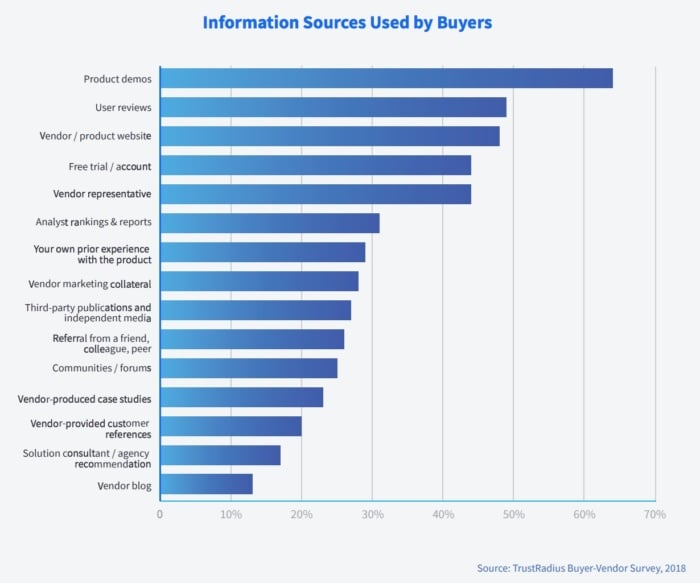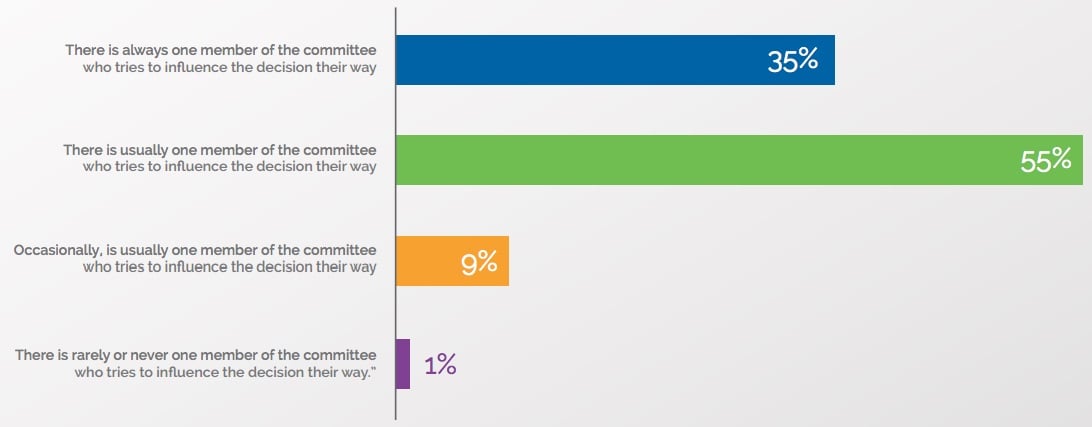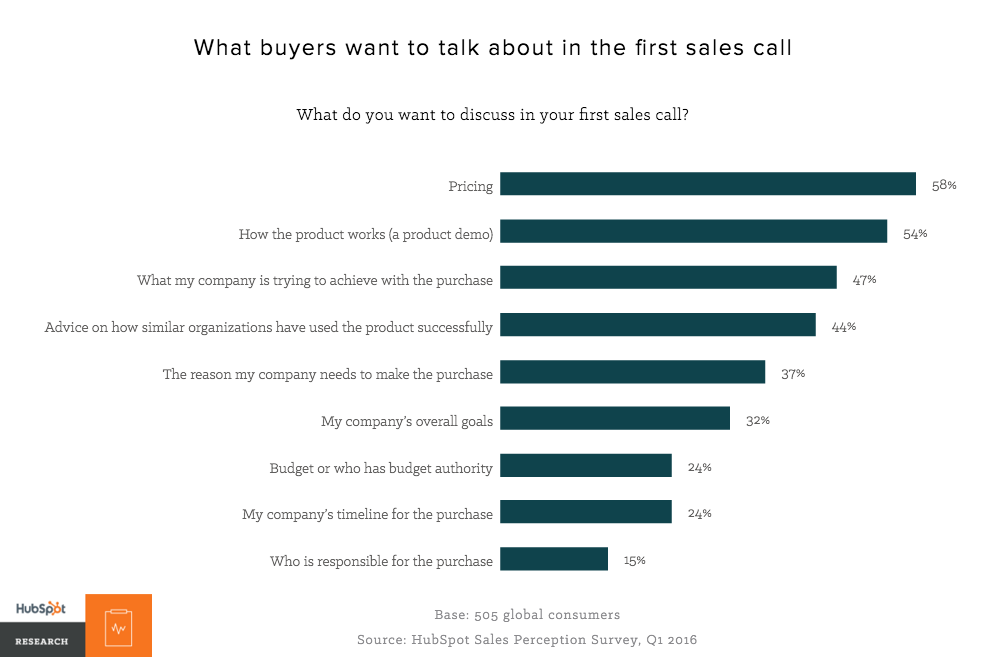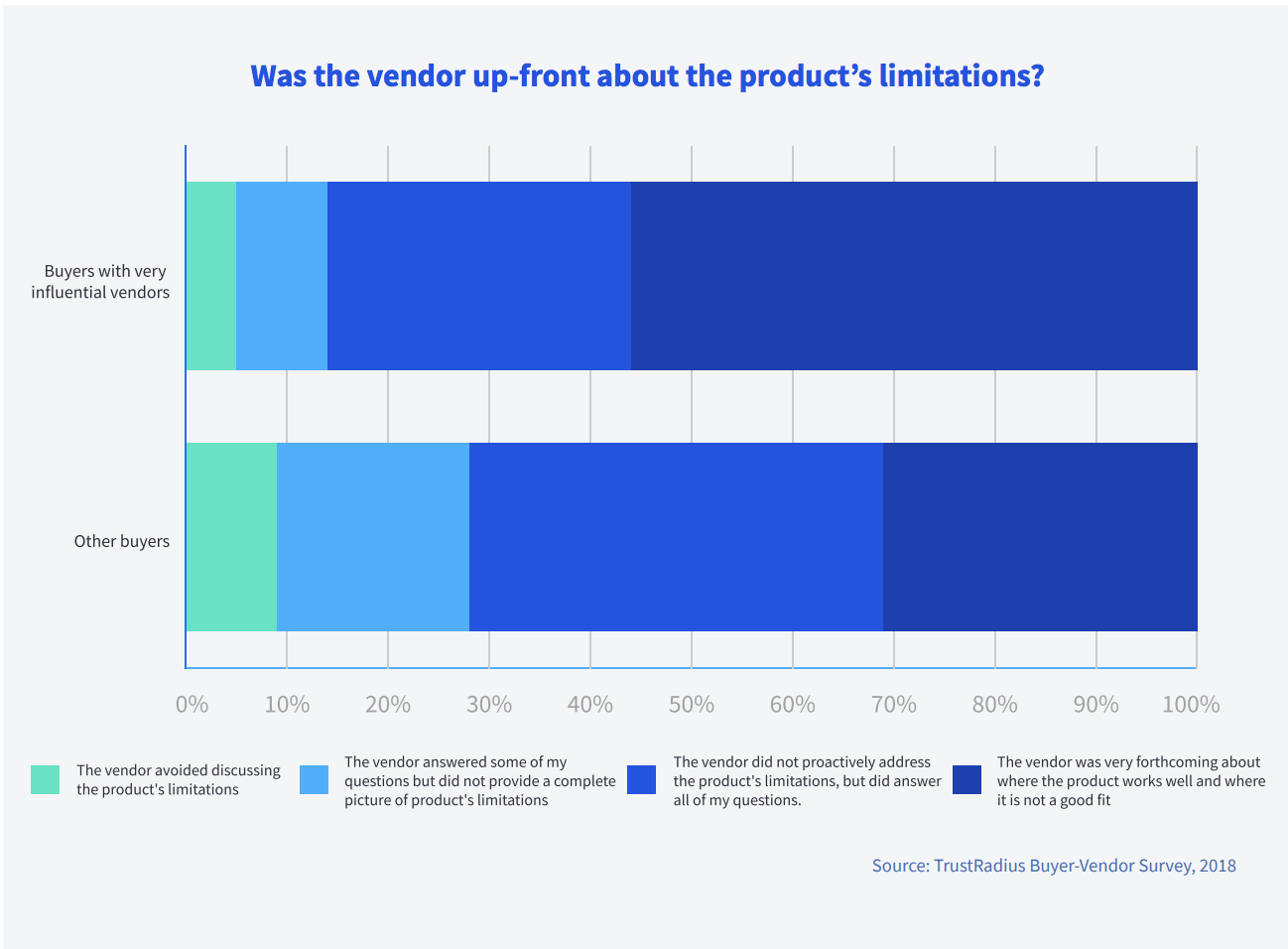
You can attribute a lot of great relationships to perfect timing. This is especially true for sales. That’s why you need a clearly defined process for generating more leads, of higher quality, that feed into a lead qualification system you’ve designed.
By taking these steps, you can reach your leads at just the right time in their purchase journey, increasing your chances of closing deals.
Generate More Leads
Most companies have a set of best practices for generating more leads, and don’t change their process for years at a time. Shaking things up a little can help you may help you find more success with lead qualification. Asking yourself a few questions may help you step up your game.
1. Where Are Your Leads Coming From?
Sales leads should be coming to you from a variety of places.
In fact, buyers typically consult almost five different information sources when deciding on products, vendors, or services.

Some may find you on social, while others may have participated in a webinar that you hosted.
Referrals are another popular way new sales prospects tend to find potential vendors or agencies. Customers or clients who come to you by referral actually have a 16% higher lifetime value.
Typically a data analyst or business intelligence employee should pull and analyze the data on where your leads are coming from, and funnel this information into your lead qualification system. You can use this data to shift your strategies if you need to.
For example, if you are getting lots of traffic but few qualified leads from Facebook, it may be time to either switch up your ad strategy or focus on other channels.
2. What Draws Clients to Your Brand?
You may think you know why clients select your brand, but there may be a disconnect between what you believe and what is real. You may know what channel your leads came from, but you don’t know what actually made them choose your business.
The simplest way to get this information is to just ask your existing clients. Their insights can help you leverage what you’re already excelling at to draw in more leads.
Maybe it was the simplicity of your website navigation or an About page that endeared you to your clients.
If you’re armed with this information, you may be able to find other qualified leads by pointing out these features or adding links to these pages in your ads, blog posts, etc.
Sales staff can be responsible for asking your client’s the question, and marketing or content can strategize and implement changes based on the responses. Capitalizing on what you’re good at can help draw more leads.
3. How Do You Solve Your Client’s Problems?
Ensure you are constantly researching trends in your industry so you can stay on top of issues that may arise. If you have a solution for a problem your target client base has, then showcase how you can help solve these problems to draw in more qualified leads.
The creative and marketing team can partner up to create ads or posts that highlight the problem and the solution you offer. Clients looking for quick solutions may be eager to sign with an agency that can help them right the ship, and if you perform well for them, the relationship could be a long one.
Lead Qualification Questions for Lead Forms
After you’ve made some improvements in your processes to bring in more (and hopefully of higher quality) leads, you’ll still need to run your leads through some kind of lead qualification process. This can be as simple as a spreadsheet, or you may use tools.
Typically, business or data analysts and sales can work together to create the lead qualification ranking factors.
You’ll need to have some basic information to run your possible clients through a lead qualification system. This can include the basics, like their name, email, company name, role, size of their company, etc. However, there a few other questions you can ask on your lead forms that will speed up the lead qualification process.
4. Who Else Is Part of The Purchasing Process?
On average, 6.8 people are part of the B2B decision-making process.
Unless you’re working with very small businesses, you’ll probably need to convince more than just one person that you’re the right agency or vendor for them.
To ensure you’re establishing a relationship with all the right people, you want to find out exactly who is involved in the process of making decisions.
You’ll also want to find out where the individual who is your lead fits within that process.
Knowing if you’re dealing with the CEO or the manager can make a major difference in how you qualify your leads. You can get this information by asking what role the lead is, and a yes or no question on whether they are the purchasing decision-maker.

5. What Are They Looking for in a Vendor or Agency?
Ask your leads what their “dream” vendor or agency would look like. If they’re filling out a lead form, you can give them a list of features and have them click three to five (or as many as they want) that are most important to them.
If your agency offers all or most of the features, then you know this is an important lead.
Furthermore, when you may not fit their criteria perfectly, having this data can help you better understand what some of your audience is really looking for. You can use this data to make adjustments to your staff, focus on creating additional features, etc.
Sales teams can also use this knowledge to explain to leads how you may make up for any of the features or characteristics they want from an agency that you don’t currently offer.
6. When Do They Want to Sign a New Agency?
This question helps you get to the roof of what the client is looking for, and how quickly they are looking to make a purchase.
The quickest way to use this for lead qualification is to add a question to your lead form about where the client is in the purchasing journey.
If they say they are in the research phase, you may want to qualify them as someone to follow up within a couple of weeks. If they are looking to find something ASAP, you can pass their info to your sales team for immediate contact.
7. What Is Their Biggest Priority Right Now?
When a new lead comes to you, they probably have a few ideas about what they’d like to accomplish. If you ask them to identify their most urgent need via multiple choice or text response questions on your lead form, you can take this into consideration when you judge their lead qualification.
If they are a promising lead, sales staff may talk to their teammates who handle the feature or product the prospect wants most to get an explanation about what makes your offerings better than your competitors.
8. What Is Their Budget?
The budget is arguably the most important part of a new partnership.
This is why almost 58% of buyers want to discuss pricing on their first sales call. However, the majority of reps say they can’t provide pricing on the first call. If you train your sales team to gauge prices better, you may have a leg-up on your competitors when closing deals.

To qualify your leads and save time, you can add a question in your lead form about how much the lead is willing to spend on your product or services.
Talking about budget expectations upfront can help you with lead qualification, as you can disqualify leads that can’t afford your offerings. Leads with higher budgets will be the highest priority.
Establishing a Relationship for Further Lead Qualification
Once you’ve qualified your leads that come in via lead forms, referrals, etc, establishing a positive relationship is the most important part of qualifying your leads and closing a sale.
When it comes time to make a purchase, your consumers aren’t going to buy from just anyone.
Instead, they’re going to turn to someone they know they can trust. Unfortunately, only 3% of people trust marketers and salespeople.

In order to be there when a client is ready to buy, you want to work on establishing the relationship early on. Clients you are able to forge a positive relationship with from initial contact may be ranked higher in your lead qualification system.
To lay the foundation for the business relationship you’re creating, here are a few questions your sales staff should be asking when following up with leads.
9. How Can We Best Help You Make This Decision?
Most sales prospect have something holding them back.
Whether it’s budget or not being entirely sure what they need, you want to find the hurdle that’s preventing your prospect from pulling out their credit card. The answer can help you with lead qualification. If you have an easy fix to the prospect’s purchasing hesitation, the lead may be more of a priority.
Once a sales rep determines what is holding the client back from the sale, they can connect the client with a team member that can best address this issue. For instance, if the client is wary of buying because they are nervous the technology is too complicated, you can direct them to your product team for a demo.
Remember to listen to your leads’ unique challenges and fears. Even if you’re trying to qualify multiple leads at once, you want each to feel special.
10. What Resources or Solutions Have You Tried in the Past? What Happened?
Ask your prospects to talk about what they’ve already tried. This can help you see if you can offer different solutions. It also helps the lead recap what they’ve already been through.
By going back and covering all the things they’ve tried and failed, you can uncover what products or solutions you can offer that will help clients succeed this time.
Arjun Varma, Sales Manager at Quantcast, uses the tactic “ask, define, explore” to get more from his prospects.
He says:
“Ask discovery questions to uncover the largest business challenges a prospect is facing. Define the implications of these challenges. Explore a partnership or sale that addresses the defined challenges and helps the customer do more business.”
You can then use this information going forward to provide them with solutions that are more likely to work.
11. What Requirements or Deal-Breakers Are There for Working Together?
Requirements and deal-breakers can sometimes be a difficult thing to talk about. Regardless of the direction the conversation goes, it’s always important to be open and honest about your product.
Discussing the deal-breakers up front can also help with lead qualification. If you can’t offer solutions or meet the client’s deal breakers, you may disqualify them as a lead.

Trying to deceive the customer into believing you offer the perfect solution will only cause headaches and frustration down the road.
In addition to being a good factor of lead qualification, this type of question can actually help you close deals. It’s called the “reverse close.”
In an article that Inc. published, the “Reverse Close” is listed as one of five key ways to close a deal. The example question used in the article is: “Is there any reason, if we gave you the product at this price, that you wouldn’t do business with our company?”
Once you know what might inhibit a deal, you can either disqualify the lead or offer solutions to ensure that the sale goes through.
12. What Are Your Greatest Strengths and Weaknesses?
Take a minute to try and understand the lead’s perspective about their own business. Ask your sales prospect to outline where they believe they shine and where they think they may be lagging behind.
Knowing how they view themselves can help you understand their priorities and how well they align with your product or services.
13. Where Do You See Your Competitors Surpassing You?
Ask your lead who they believe their competitors are. Then ask how they believe their competitors are surpassing them.
By getting them to think about the areas their competitors are doing better in, they can better understand the solutions they need to implement to see similar success.
This can give both of you a better idea of what steps you need to take moving forward.
14. What Hurdles Might We Run into Down the Road?
It’s impossible to know exactly what hurdles will show up when you’re working with a new client or customer. However, determining what they could be can help you plan ahead.
If you foresee any long-term issues, discuss them with your lead. Salespeople may need to consult with product or content teams to better understand the possible hurdles and if they can be overcome. If not, it may be time to disqualify the lead. If so, offer up these solutions to the lead to help you close the deal.
Timeline Expectations for Lead Qualification
You should already ask your leads about their timeline via the lead or referral form. Once you’ve established contact, you can do a deeper dive into the prospect’s ideal purchasing schedule.
Discussing a timeline upfront can help you identify when the prospect might be willing to buy and what commitment they’re looking for from you and your team. You can consider their response in your lead qualification process.
Here are a few questions your sales staff should ask to learn more about your prospect’s purchasing timeline.
15. What Is the Timeline for Their Goals?
Talking about goals is great, but it’s more important to know when your leads hope to accomplish those goals.
Getting a timeline for when your leads would like to achieve their priorities can help you better understand what kind of commitment they’re looking for, and qualify them accordingly.
For instance, if a lead needs to accomplish their goals within just a few weeks, they may be looking to hire a committed team immediately.
On the other hand, if they have no idea when they’d like to accomplish their goals, they may need some more nurturing and education.
Sales staff should be sure to communicate with team members who are responsible for delivering on client’s goal within the requested time frame.
Sometimes they may not be able to accomplish the client’s goals by the time they want, and you’ll need to decide if the team should shuffle their priorities, present an alternative timeline to prospects, or disqualify them since you’re simply unable to meet their needs on their schedule.
16. Do They Have Any Outside Factors Influencing Their Timeline?
Your leads may have an idea of when they’d like to get started or complete their goals. However, it isn’t always in their control. Sometimes, outside factors constrain leads.
External due dates and other factors can make your sales reps’ jobs more complicated. At times, external factors can influence when a deal can actually go through.
Whether they have a contract they need to see through or they have a deadline they’re scrambling to meet, you’ll want to ask if there are any outside factors that will influence your leads’ timeline.
For lead qualification, a prospect who is ready to buy may be ranked higher than one who can’t pull the trigger yet for external reasons.
17. How Soon Do They Want to See Results?
Knowing what kind of turnaround your prospect is expecting can help you better understand when they may be willing to make a commitment.
If they want to see results in just a few weeks, you’ll want to get started right away.
However, if they have no idea when they’d like to start their progress, they’re probably not yet ready to make a purchase and may be classified as a lower-priority lead.
Establishing Future Success
It’s always more efficient to gain repeat customers than it is to constantly connect with new prospects. This is why you should always plant the seed of a long-term relationship when you’re still in the nurturing process with your qualified leads.
Letting your sales prospects know how you can help them through growth and changes can help you secure long-term relationships with them.
Here are a few questions sales team should ask to help establish a future relationship.
18. How Do They Measure Success?
Ensure you discuss your leads’ goals when you establish contact. Some may only be searching for more revenue, while others may want more positive customer reviews.
It’s important for salespeople to discuss their leads’ KPIs with the teams that will help meet them. You need to know how realistic it is to meet these metrics and qualify leads accordingly.
19. How Do They See Their Needs Changing as They Grow?
Your sales leads are looking for a solution to problems they have now. However, if you can also provide solutions for the future, you can help them achieve growth with a smoother progression.
Helping them understand how their needs may change as they grow – and how you can be there to help them solve new problems or meet new goals – can help set you up for a long-term partnership.
Sales staff should be trained on and aware of industry trends that may affect the client’s future success, or speak to members of your team who specialize in the issue that may cause trouble later on.
By getting ahead of possible issues, you paint a picture of a partnership between you and the lead that persists long into the future.
20. Where Do They See the Relationship Going Moving Forward?
Find out early if they’re only looking for a short-term deal. Are they just looking for someone to help with their current goals, or do they want a long-term partner who can help them overcome future hurdles?
If they’re looking for something short term, they’d rank as a lower priority lead. Don’t disregard these leads completely, however; short term deals can turn into referrals, and if you do a great job, short-term deals may grow into long term ones.
For PJ Pereira of Pereria & O’Dell, a willingness to collaborate is one of the most important factors when choosing a new agency to work with.
Showing your prospects that you’re thinking about how you can keep the relationship going as they grow might encourage them to work with you over a competitor.
Conclusion
Quit playing the guessing game when it comes to lead qualification and connecting with sales prospects.
If you want to stop missing out on high-quality leads, stop assuming that you know when leads are ready to make a purchase.
Instead, let them tell you when they’re ready – even if they don’t realize they’re doing it.
By asking these 20 questions of yourself and your leads, you can get a better idea of who your prospect is, what their lead rank is, what they’re looking for, and how you can help them.
If you want help finding and closing sales with your leads, we can help!
What questions do you like to ask your sales prospects?
The post 20 Questions for Faster and Better Lead Qualification appeared first on Neil Patel.
No comments:
Post a Comment